Follow the Water Buffalo
One weekend we decided to take Mom to the pyramids at Saqqara and Dashur. So, we packed a lunch, grabbed our friend Ben, and the four of us set out on Saturday. Besides, you just can’t have more fun around Cairo than on a driving trip!
Living in Egypt and visiting the pyramids can be equivalent to living in D.C. and visiting the Air and Space Museum or living in Orlando and checking in on Mickey and gang every time you have houseguests. It can get a little tedious. I mean, let’s be honest, the pyramids are spectacular, however they haven’t changed a lot in the last 4,000+ years, and your first 15 photos of a pyramid, tend to look a lot like your next 15 photos, and the 15 after that (or, if you’re me and a photo-nut, make that 85 photos). So the question becomes, how do you keep a visit to a 4,000-year-old stone structure fresh and new? One way is to follow Mr. Frost’s advice and take the road less traveled (albeit shared with donkeys, delivery trucks, slews of water buffalo and the occasional camel) and take a venture out to the Saqqara and Dashur pyramids.
I cannot stress enough the importance of enjoying the “journey” here in Cairo. Whether we’re speaking metaphorically, or realistically, half of the fun of anythere here is merely getting there. So we took the Ring Road out and grabbed the “Sakkara” exit and started on our drive along the canal (one of many off-shoots from the Nile). Along the way we played versions of “Identify That” in the canal to pass the time (no identifiable bodies this time, though Mom was admittedly not looking for them). We also saw piles of burning trash, irrigation pumps pouring putrid water into the surrounding fields growing cabbages, cauliflower and such, small stands selling fruit and veg alongside the road (I do wonder who their primary clientele is), bunches of carpet factories and “schools”, huge trucks laden with bricks or sugar cane or swaying grasses, water buffalo seemingly out for a morning stroll and donkeys galore. 
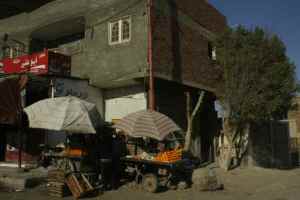
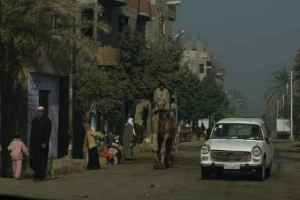
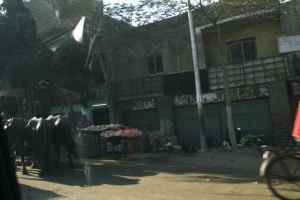







At one point we came upon two little boys, about 8-10 years old, driving along in a motorcycle-truck contraption. As we passed them, Ron rolled down the window and asked them if they had a license. They replied but I’m not sure what was said, but there were a lot of laughs. 

We decided to hit Dashur first, which was farthest away, so we passed the sign for Saqqara (also spelled, Sakkara) and continued on as the road got a little more rural (meaning more carts and tractors, ambling water buffalo and low-flying shuttle busses, but on a 1½ lane road). At one intersection we saw a sign for “Seniphro Dahshour” off to the right. We knew to look for it as last time we flew past (it’s not necessarily designed to be helpful) and had to ask for directions. 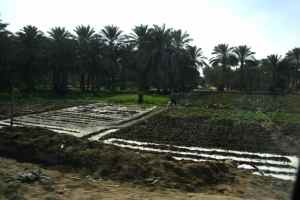
Along a road lined with palm trees, lush fields and slumbering sheep and goats, we came to the gate. Here we were approached by the guards and twice now we have been asked where we’re from and where we’re going afterwards. Our first visit we were kindly told, “You visit, then you leave.” Fair enough. This time Ron, having apparently eaten several helpings of Wheaties that morning, told the guards that we were next going to Saqqara, then off to Giza, then some shopping at CarreFour and maybe a jaunt to Alfa Market. Luckily they appreciated his sense of humor, didn’t shoot us, and we were allowed entry.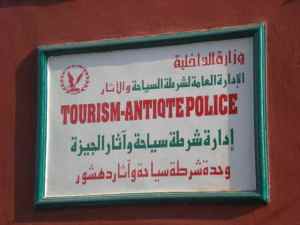
Dashur is a very different site than both Saqqara and Giza, mainly due to its remoteness. It’s also surrounded by an Egyptian military base, so while we didn’t have to deal with the din of other tourists, we were serenaded by the sounds of practice-time at the shooting range. But I’m sure it’s perfectly safe.
Dashur is made up of essentially three pyramids. The Red Pyramid, which you come to first, and the Bent Pyramid, which you drive a little farther to, were built by Sneferu, who reigned around 2613 BC and was the father of Khufu, who built the pyramids at Giza. 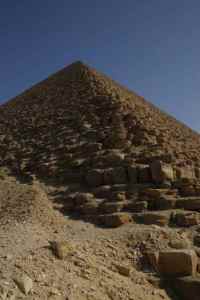






As happened the last time we were here, the ever-helpful police on camels tried to “guide” us around, but Ron was assertive enough to dissuade them (you definitely need to assert strongly your desire to explore alone). However we did take a moment to enjoy them stalking Ben, who had to make the same assertion. Luckily a few other tourists arrived, so the “guides” moved over to them. 


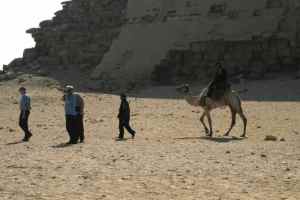
The Red Pyramid can be entered, however based on others’ claims of stuffy, claustrophobic conditions resulting in an empty chamber, we have opted to skip it. But we did thoroughly wander. Mom took to examining it up close and spotted a beautiful large dragonfly and finding such delight in seeing any wildlife in Cairo, I dutifully took the requisite 12 photos. Then Ron had another Wheaties-induced moment and insisted on us performing a Foxtrot in front of the pyramid, which Mom happily documented.

From here, we traveled over to the Bent Pyramid, which is reached by car on a bone-jarring, suspension-testing ride through the desert. The theories surrounding the change in angle half-way up the sides vary greatly, so suffice it to say, no one really knows why it’s “bent.” But due to its steep angle, much of the original limestone facing remains intact, which cannot be said for the others. 


Mom found great glee in sifting through the loose rocks, finding smooth colorful ones that somehow made it into our car (and are currently nestled in our outdoor plant). We did have to stop her from performing her own excavations though. 
The third pyramid in this grouping, the Black Pyramid, built around 1800 BC, is seen in the distance and appears to be a nubble on a rubble pile (not necessarily the guide-book description). We thought about testing the 4-wheel-drive capabilities of our Jeep and going to check it out, but figured it might result in a camel-police chase and despite the “bloggability” of that, we opted to just appreciate it from a distance. (The two dark specks in the photo below are actually Ron and Ben, I promise.)
From here, we took the canal road back towards Saqqara. One thing immediately apparent when you arrive at the gate here is the dramatic delineation between the green fertile fields of palm and the sudden stark desert. Plus the guards don’t try to run you off.
We stopped first to get a ticket for Mom, though in hindsight we didn’t need to. As “Dips” the rest of us get in free (whee!). Ron, feeling a Wheaties-surge again, tried to tell the ticket man that Mom was a very important person, and secretary to Hillary Clinton. The man didn’t buy it, so we bought a ticket. On arriving at the entrance to the Step Pyramid, a man approached us and asked for our tickets. We dutifully showed him our Dip cards but Mom had left her ticket in the car. He said that was fine, and then attempted to sell us a tour – he was a guide, not even a ticket taker!
The complex at Saqqara covers four miles and is older than Giza (though it doesn’t have a view of a KFC, like at Giza) and its centerpiece, the Step Pyramid, is said to be the oldest known stone structure on Earth (a rather nice claim to fame). It was built for King Djoser, who reigned around 2635 BC, and was designed by Imhotep who was later deified and is believed to be the first engineer, physician and architect recorded in history. 



There are 16 pyramids in various forms of rubble, plus tombs and temples strewn throughout Saqqara. It has fantastic views and several interesting finds, including the Tomb of Teti (~2290 BC) which is one of only a few tombs that visitors can crawl into down a crouch-inducing tunnel that opens into three rooms with original hieroglyphs adorning the walls. Apparently Teti’s name is written using two half-circles and a feather-like icon, which can be seen all over. One room also houses an enormous basalt sarcophagus whose inhabitant could have gazed upwards at the stars adorning the ceiling. While it might not measure against our current feelings of “home,” it is astounding to find yourself standing exactly where others stood over 4,500 years ago. Then reality returned and we resumed the crouch position and crab-walked back up the tunnel to daylight.



We also explored the Tomb of Mereruka, who was Teti’s son-in-law, which has an impressive array of 33 rooms decorated in stone carvings, some from floor to ceiling, and many with their original colors. 

Opting to use the lavatories back at the entrance instead of these by the car park (not sure what vaccinations may be required), we drove back and also checked out the Imhotep Museum, newly opened in 2006 (thanks to the French). As museums go, and in particular Egyptian ones, this is a really well-displayed and well-labeled collection of artifacts from all over Saqqara. 
Last, but by far least, was the drive home; replete with physics-bending vehicles, adventurous fisherman on the canal, canal banks held up by trash, cabbages the size of Golden Retrievers and glimpses at true life outside of Cairo. Oh, and I guess I could mention the fruit seller who used an impromptu method for washing off his strawberries by spraying them with a mouthful of water. Ben promptly announced his refusal to ever buy local produce again, and as of two months later has remained true to his claim. Life in Cairo, where the adventure (and possibility of contracting TB) never ends.



